| La Fortaleza | |
|---|---|
Palacio de Santa Catalina | |
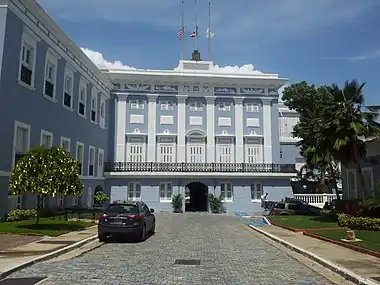 | |
| General information | |
| Architectural style | Hispanic Renaissance, Neoclassical |
| Location | San Juan, Puerto Rico |
| Address | 63 Calle Fortaleza, San Juan, Puerto Rico 00901 |
| Coordinates | 18°27′50″N 66°7′9″W / 18.46389°N 66.11917°W |
| Completed | 1540 |
| Website | |
| Official Govt. of Puerto Rico Site (in Spanish) | |
| Type | Cultural |
| Criteria | vi |
| Designated | 1983 (7th session) |
| Part of | La Fortaleza and San Juan National Historic Site in Puerto Rico |
| Reference no. | 266 |
| Region | The Americas |
| Official name | La Fortaleza |
| Designated | October 9, 1960[1] |
| Reference no. | 66000951 |
| Official name | La Fortaleza |
| Designated | October 15, 1966[2] |
La Fortaleza (lit., "The Fortress") is the official residence of the governor of Puerto Rico and has been since the 16th century. It was built between 1533 and 1540 to defend the harbor of San Juan, in Puerto Rico. The structure is also known as Palacio de Santa Catalina[3] (Saint Catherine's Palace). It is the oldest executive mansion in continuous use in the New World. It was listed by UNESCO in 1983 as part of the World Heritage Site "La Fortaleza and San Juan National Historic Site".
During the 1640 reconstruction, the chapel of Santa Catalina, which originally stood outside the walls, was integrated into the structure's walls, resulting in the alternate name Santa Catalina's Castle.
The structure
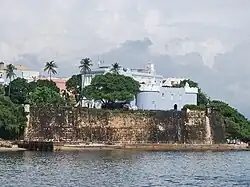
La Fortaleza was the first defensive fortification built for the city of San Juan and the first of a series of military structures built to protect the city, which included the Fort San Felipe del Morro and the Fort San Cristóbal. The construction was authorized by Charles V, Holy Roman Emperor as a defense against attacks from Island Caribs and the European powers of the time.
Initially, the structure consisted of four walls enclosing an interior patio with a circular tower known as the Homage Tower. From the top of the tower, following military tradition, the governor would take fidelity oaths at critical moments to the King and Queen of Spain. Later, a second tower named the Austral Tower was constructed.
The complex currently consists of a few attached buildings with formal living quarters on the second floor and private quarters on the third. It overlooks the high city walls that front the bay, and within the north perimeter of the house are sheltered gardens and a swimming pool.
History
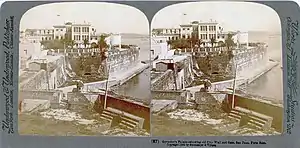
Starting in 1529, Governor La Gama petitioned the emperor on the need to build defensive fortifications "because the island's defenseless condition caused the people to emigrate." Construction started in 1533, using stone, and concluded by 1540. Yet the fort had no guns, and Gonzalo Fernández de Oviedo y Valdés commented, "if it had been constructed by blind men could not have been located in a worse location." Yet the structure has served as the governor's residence since 1544.[4][5]

Since the 16th century, La Fortaleza has acted as the residence of the Governor of Puerto Rico, making it the oldest executive mansion in continuous use in the Americas.[6] The mansion was remodeled in 1846 by the Spanish authorities to adapt its military origin to its new purely administrative function.
La Fortaleza has been captured twice by invaders:
- 1598, George Clifford, Earl of Cumberland, attacked San Juan.
- In 1625, General Boudewijn Hendricksz (Balduino Enrico) of the Netherlands invaded the city and established himself at La Fortaleza. During the Dutch retreat, the fortress and the city were set ablaze.
- 1898, the U.S. Navy invaded and occupied Puerto Rico, establishing a provisional government.
In 1834, Colonel George Dawson Flinter described the fortress of Santa Catalina as having a chapel, stables, cistern, and an east wing with spacious apartments.[7]
According to tradition, in 1898, just before the United States invaded Puerto Rico during the Spanish–American War, the last Spanish governor of the island, Ricardo De Ortega, struck a longcase clock in La Fortaleza with his sword, stopping the clock and marking the time at which Spain lost control over Puerto Rico.
On October 30, 1950, there was an attempt by a few nationalists to enter La Fortaleza in what is known as the San Juan Nationalist revolt, intending to attack then-governor Luis Muñoz Marín. The 5-minute shootout resulted in four Nationalists dead: Domingo Hiraldo Resto, Carlos Hiraldo Resto, Manuel Torres Medina, and Raímundo Díaz Pacheco. Three of the guards of the building, among them Lorenzo Ramos, were seriously injured.
On October 9, 1960, La Fortaleza was designated a United States National Historic Landmark.[1][8] Teodoro Vidal, a cultural affairs official official under Luis Muñoz Marín, organized renovation work on the building around this time.[9]
In 1983, La Fortaleza, along with the San Juan National Historic Site, was declared a World Heritage Site by UNESCO.[10]

Trivia
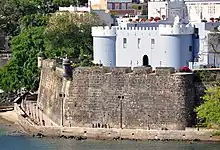

La Fortaleza has had 156 governors: 124 under the Spanish regime, 19 under the U.S. regime and 13 Puerto Ricans, 11 elected, one appointed by the President of the United States Jesús T. Piñero and one sworn in by the Constitution of Puerto Rico Wanda Vázquez Garced.
The Hundido Garden was named Doña Inés Garden in honor of Doña Inés Mendoza, wife of former governor Luis Muñoz Marín, because that was her favorite spot at La Fortaleza, where she lived for 16 years.
Three flags fly over La Fortaleza: the Puerto Rican flag, the United States flag, and the Governor's white flag. When the white flag is not raised, it is because the governor is outside the Santa Catalina Palace.
The Homage Tower houses the Santa Catalina Chapel, where a colorful mosaic of 95,000 pieces in honor of the Holy Trinity stands out.
The paintings exhibited at La Fortaleza are on loan from the Institute of Puerto Rican Historical Culture and are changed according to the taste of the ruler of the day.
Originally, La Fortaleza was painted salmon red, the characteristic color of the island's military installations of the time of Spanish colony. Its wooden doors were green and its columns were painted white with gold details.
La Fortaleza has two towers: the Astral Tower and the Homenaje Tower (Homage Tower), which show that it was originally a military structure.
In 1956, when an area covered with a panel was uncovered, what could be the old kitchen of La Fortaleza was discovered in the Austral Tower.
In literature
In 2011, Puerto Rican author Giannina Braschi wrote the dramatic novel United States of Banana, featuring climactic scenes of revolution at La Fortaleza.
Gallery
 La Fortaleza palace at the 4th July 1899.
La Fortaleza palace at the 4th July 1899.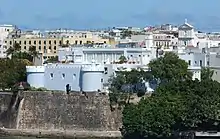 La Fortaleza, photo of 2004
La Fortaleza, photo of 2004 La Fortaleza
La Fortaleza Original "Throne Room", currently Governor's Office, La Fortaleza. In 1933. Photo by Jack E. Boucher. Historic American Buildings Survey.
Original "Throne Room", currently Governor's Office, La Fortaleza. In 1933. Photo by Jack E. Boucher. Historic American Buildings Survey. La Fortaleza in 1933. Photo by Jack E. Boucher. Historic American Buildings Survey.
La Fortaleza in 1933. Photo by Jack E. Boucher. Historic American Buildings Survey.
See also
References
- 1 2 "La Fortaleza". National Historic Landmark summary listing. National Park Service. Archived from the original on 2007-08-09. Retrieved 2007-06-28.
- ↑ "National Register Information System". National Register of Historic Places. National Park Service. April 15, 2008.
- ↑ Rivero Méndez, Ángel (2 September 2019). "Crónica de la guerra hispano-americana en Puerto Rico". Wikisource (in Spanish). p. 23. Retrieved 2 September 2019.
- ↑ Van Middeldyk, R.A. (1903). Brumbaugh, Martin (ed.). The History of Puerto Rico: From the Spanish Discovery to the American Occupation. D. Appleton and Company. pp. 109-110. Retrieved 6 March 2019.
- ↑ The Forts of Old San Juan. Washington, D.C.: Division of Publications, National Park Service, U.S. Dept. of the Interior. 2018. pp. 24–27. ISBN 9780912627625.
- ↑ "Collections". National Museum of American History. Retrieved 13 April 2018.
- ↑ Flinter, George Dawson (23 October 2016). "An Account of the Present State of the Island of Puerto Rico". Internet Archive. Retrieved 5 May 2020.
- ↑ McKithan, Cecil N. (August 1981). "National Register of Historic Places Inventory-Nomination: La Fortaleza". National Park Service. and Accompanying photos and diagrams, undated
- ↑ "Teodoro Vidal Santoni (1923-2016): la trayectoria de un coleccionista". 88 Grados.
- ↑ "WH Committee: Report of 7th Session, Florence 1983". whc.unesco.org. Retrieved 13 April 2018.
Further reading
- Government of Puerto Rico. Executive Mansion: Santa Catalina's Palace. San Juan, Puerto Rico. (in Spanish)
- World Heritage Committee. Report of 7th Session, Florence 1983. Paris: UNESCO's Convention Concerning the Protection of the World Cultural and Natural Heritage. January 1984.